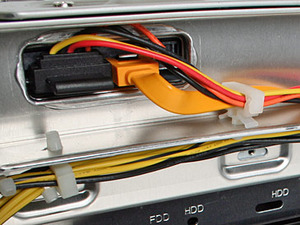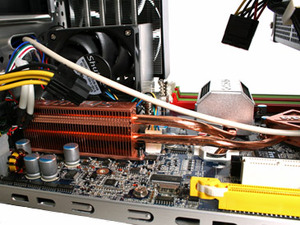Hardware Installation
Four thumbscrews and the top comes off with ease, revealing space for two hard drives in the top and a pair of 60mm fans to cool them. Well, to cool the rear hard drive at least. Each of the aluminium parts comes out, as we are used to seeing in Shuttle XPC chassis. When all’s said and done, there are only five pieces that need removed - three aluminium pieces for the drives, the cooling system and its fan.Little tip for you - DON'T remove the motherboard. This system has more connectors and cables than your average XPC and it’s easy to get confused. Plus, it's a bit of a nightmare to get in and out. You shouldn't need to anyway, everything just drops right in - CPU, memory, graphics, hard drives.
When you’re choosing the hard drives, you'll need to use SATA drives – this is not a big ask considering IDE drives were all but phased out several years ago. The case is also specifically designed with cables pre-routed to accommodate SATA hard drives in the top. While this design has been clearly thought out down to providing cables of specific lengths, Shuttle could use some better SATA cables that have the connectors angled 90 degrees sideways instead of downwards – this is especially true when you consider where the cable is routed.
Regardless, there are finally four SATA ports included which means you can ditch the cumbersome IDE cable altogether, especially since a SATA DVD-RW optical drive costs the same or less than an IDE one anyway. A perfect excuse to upgrade!
The board features an interesting and vibrant colour scheme, like many ATX boards we've seen in recent times, and as with many boards we see today, Shuttle has included a heatpipe array connecting both north bridge and south bridge to the larger heatsink that also cools the power regulation components. These fins are cooled by the airflow from the CPU fan, creating a multi-purpose application for the ICE cooler that reduces the need for more fans, even though it does add heat to the CPU fan’s air intake. Without the OASIS cooling there would be a tiny, annoying little fan on the north bridge and likely some very hot mosfets - a situation which we've seen before on other XPCs.
In addition to its colour scheme, the motherboard gets the all solid aluminium capacitor treatment - something that's actually more useful considering the higher case temperatures in the XPCs. There are also all of the usual features included, such as Gigabit Ethernet, IEEE1394a Firewire and Realtek High-Definition audio with S/PDIF. Shuttle has gone to the extra effort of including the more expensive DD version of the Realtek ALC888DD codec, which includes extra Dolby Digital features. It's worth doing even if it does increase the cost, since there is limited expansion space to include your own sound card.
You also get four memory slots packed in, making this good for an 8GB machine - potentially opening up a situation where you could stack nine in the space of three ATX cases for any number of clustered distributed computing activities.

MSI MPG Velox 100R Chassis Review
October 14 2021 | 15:04













Want to comment? Please log in.